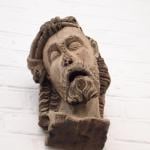RENE MAGRITTE, MASTER OF HORROR: Me and my big mouth. I was really psyched that Sean Collins decided to dedicate his October blogging to horror-related posts, and fired off an email in which I asked whether he was a Magritte fan, and, if so, whether he’d be interested in blogging about the Belgian surrealist’s use of horror imagery.
Like so many people to whom I shoot oblique, half-thought-out one-liners, he replied, “Hey, intriguing! Why don’t you do it?”
Um, because I didn’t know what I was talking about? My muse is intermittent at best, babe.
Nonetheless, I’m right. Magritte is a horror artist. I’m going to try hard to explain what that statement means, but be forewarned: This post is even more scattered than usual, and I’m not going to spend my time looking up pictures on the Internet (too late at night), so, um, the big book o’ Magritte I’m using is Magritte, ed. Sarah Whitfield, South Bank Centre, 1992. I’ll describe the pix, though that’s nothing at all like seeing them, and I’ll also be dropping several general comments about Magritte and horror that should be of interest even if you don’t have the paintings in front of you.
First off: Magritte is not a horror artist just because he’s a surrealist. Lee Miller–possibly my favorite visual artist of all time ever–is also a surrealist, and her photographs give me none of the haunted, creepycrawly, horrorshow sense that saturates Magritte’s work.
In part, that’s because Miller moved out of her own head into World War II. In part, that’s because she was presenting the wreckage of a beautiful order–there’s a far greater sense of wrecked beauty in her works than in Magritte’s, where the emphasis is more on lost meaning.
Both emphases seem to me to portray a world that is neither good, nor bad, but Fallen; but Miller’s work is much more obvious about that than Magritte’s. It’s possible, although I don’t think this is the right interpretation, to come away from Magritte’s work thinking it portrays a world that is intrinsically, essentially absurd, that there is no hope for a recovery of meaning or a redemption. It’s a lot harder to come away with that view from Miller’s pictures, especially her WWII period, when she was doing her greatest work.
For me, the classic Miller picture is her photograph of the soprano singing, silhouetted, in the ruins of the bombed-out opera house. Nothing in Magritte’s work relies on the same sense of a preexisting order, and nothing in his work relies on the same charged, obvious, exquisite beauty among the ruins.
So okay, it’s not just his surrealism, although doubtless that helps. Surrealism provided a genre in which he could work out his obsessions and anxieties–basically, it did for him what suspense did for Hitchcock. Here’s my partial list of Magrittean obsessions, themes to which he returns again and again (often returning, as well, to their characteristic images):
–loss of identity… inability to view or understand oneself… something usurping one’s identity. You see this everywhere in his work–all those mirrors that reflect the back of the head that faces them, so the viewer never gets to see his own face (check out the title of one of those paintings, La reproduction interdite–this guy is being specifically denied his own reflection by some outside, unknown, almost bureaucratic, impersonal force). All those headless torsos, scuba-divers whose heads have been replaced by blocks of wood, lovers kissing with their heads wrapped entirely in white sheets, a woman’s face with a jagged strip ripped off and floating in space.
Two of Magritte’s most famous paintings put an even more bluntly horrific spin on this idea: Le viol and Les jours gigantesques (The Rape and The Titanic Days). In Le viol, a woman’s facial features are replaced by her sexual organs–her breasts replace her eyes, her pubic mound her mouth. Les jours gigantesques (which serves as the cover image for Whitfield’s book) shows a man clad in a suit attacking a naked woman as she tries to fend him off. Well, sort of. The man can only be seen in the places where his body overlaps with hers. Here, let me try to find an image of it so you can see what I mean: here.
In both of these paintings, identity is defined through sexual violation. In the first one, a woman’s identity is defined by the way her viewer reduces her to her sex organs; in the second, a man’s identity is reduced to his act of violation. Both of these pictures strike me as haunting, true, frightening, and sad.
–threats from the everyday. The sky is one of the big culprits here. “The muscles of the sky” pulse menacingly onto a wooden stage; a host of butchered birds, thickly coated with crimson blood and pulled gray feathers, hang in “The murderous sky”; a picture of a bright blue expanse with pretty white clouds is titled “The curse.” (In this last painting, as in several other Magritte pieces, the title functions basically like the music in movies, sending an opposite emotional charge to the one set up by the imagery in the painting, and thereby complicating the picture and putting the viewer on edge, apprehensive.)
I note that this sense of being attacked by something that should be utterly normal and familiar is what Stephen King does best. It’s the whole idea behind Cujo, and in that book it’s mirrored in the subplot about the Sharp Cereal Professor. It’s the reason King’s use of pop culture (“Oz the Gweat and Terrible” and the Ramones’ “Hey, ho, let’s go” in Pet Sematary, for example) is so powerful.
Similarly, lots of Magritte’s paintings deal with violations of the normal. I’m pretty sure I read somewhere that lots of his backgrounds, e.g. skies and beaches, were painted from picture-postcards; they’re aggressively everyday. His houses, similarly, always look like they’d be right in place in a children’s book or a realtor’s brochure. Except for the, oh say, giant gray alien jingle-bells hanging over the house. Or the fact that the house lives in a lamplit nighttime, while the sky above the house is sunny day. Magritte renders textures (wood, fur, fancy suits, skin) very carefully–and then rips off strips from his figures, or melts their edges, or (often) takes their heads off, or parks them sideways on the canvas. This again is much like Stephen King, a relentlessly tactile, specific writer. (On a good day, anyway. Both Magritte and King have produced a big ol’ pile of not-so-much, too.)
–a variant on both of these ideas: the truly creepy blending of organic and inorganic, human and environment. For example, a table with one leg that’s, uh, leg-shaped. Battered, broken boots that melt into hard-worn feet. An eye in a pancake (although I still prefer an “Eyeball in My Martini“) or a block with eyes.
One of the weirdest, niftiest Magritte paintings is Grelots roses, ciels en lambeaux (Pink bells, tattered skies). It’s divided in half. On the left is a standard, bland Magritte blue sky with clouds. On the right it’s kind of like a psychedelic photo-negative: It’s hard to tell which is sky and which is cloud, but one is electric blue and the other is an electric salmon pink (good grief is that a weird color!), and there are those enormous alien jingle-bells again. To me, this painting feels like blinking: Eyes open, everything’s normal, then you blink and everything’s insane–which is real? Why do you have these hallucinogenic, apparently meaningless images trapped behind your eyes?
It’s one of the most cinematic paintings I can think of; or, if you take my “blink” interpretation, you could consider it sequential art–comics. Except that it’s not. It’s a painting. And so its two images draw you, not forward into a narrative (as a movie or a comic would), but back around to the first image, in a cycle that traps you in a mystery with no solution. Is this just a pretty blue-and-pink picture–or is it a hallucination, an invasion by the irrational?
Magritte even rings his own changes on that classic nightmare/”monster under my bed” image: the door that Something has broken through. His “La reponse imprevue” (The unexpected answer) shows a normal, ordinary, Stephen King wooden door through which something mostly-human-shaped has… melted. And vanished. It either disappeared into, or (worse!) came from, the deep shadows behind the door. That’s basically night-light territory, right there. Yet by melting the door, rather than breaking through it, the Whatever It Is adds an element of mystery and organic-ness–merging with our everyday environment, not destroying it–that’s even eerier than our childhood bogeymen.
I’ve gone on too long already. There’s more to say: reading Magritte’s antiwar paintings, esp. Le survivant, in light of the “Horrors of War” chapters in David Skal’s Monster Show; talking about the childish and/or fairy-tale creepiness of many of Magritte’s fauve paintings; talking about the way that even Magritte’s absurdities rely on an underlying logic, meaning, and language of physical objects, even a “language of the body” (easiest example here is probably the various paintings in which an egg replaces a bird, but actually I think you can make this case for almost all of his work). But I’ll leave that either for you all, or for later days.
I’m a philosophy major turned journalist. In other words, a professional amateur, a committed dilettante. This is my unschooled, gut reaction to RM’s pictures. I’m very, very interested in anything you people have to add, anything you want to contest or expand on.
“Belgium is an absence of identity.”
–Belgian surrealist motto











